Nuuk
| Nuuk Godthåb |
|
|---|---|
| — City — | |
|
|
|
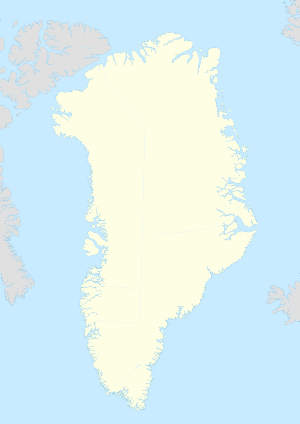 Nuuk
|
|
| Coordinates: | |
| Federacy | Kingdom of Denmark |
| Country | |
| Municipality | Sermersooq |
| First Settled | 2000 B.C. |
| Incorporated | 1728 |
| Government | |
| - Mayor | Asii Chemnitz Narup (Inuit Ataqatigiit) |
| Population (2010) | |
| - City | 15,469 |
| - Metro | 18,039 (including Qiisumooq/Ingestad village) |
| City and metropolitan population is co-extensive, The entire Metro area belongs to Nuuk City | |
| Time zone | UTC-03 |
| Postal code | 3900 |
Nuuk, (pronunciation translated: "The tip" (Danish: Godthåb translated: "Good hope") is the capital and largest city of Greenland, and the seat of government for the Sermersooq municipality. It has a population of 15,469 (as of January 2010),[1] making it one of the smallest capital cities in the world by population.
Contents |
History
The site has a long history of different inhabitation. Nuuk was first occupied by the ancient pre-Inuit, Paleo-Eskimo people of the Saqqaq culture as far back as 2200 BC when they lived in the area around the now abandoned settlement of Qoornoq.[2] For a long period it was occupied by the Dorset culture around the former settlement of Kangeq but they departed from Nuuk district before 1000 AD. The Nuuk area was later inhabited by Viking explorers in the 10th century, and shortly thereafter by Inuit peoples.[3] Inuit and Norsemen both lived with little interaction in this area from around 1000 AD until around 1500 AD, when Norse habitation stopped, most likely due to change in climate and vegetation.
The city was founded in 1728 by the Danish-Norwegian missionary Hans Egede who had arrived in 1721, and given the name Godthåb (Good Hope).[3] Hans Egede had arrived at a place close to the already existing Inuit population living in Kangeq. At that time, Greenland was a Norwegian colony under the Dano-Norwegian Crown, but the colony had not had any contact with Norway proper for almost three centuries . King Frederick IV sent three frigates to Greenland soon after Egede established it, bringing personnel and materials to build a fort. Most of the personnel consisted of convicts and prostitutes and most died within the first year of scurvy and other ailments. In 1733 to 1734 a smallpox epidemic killed most of the native population as well as Hans Egede's wife.[4] Hans Egede went back to Denmark in 1736 after 15 years in Greenland leaving his son Paul Egede to continue his parent's work.[5]Moravian missionaries took over the area.
Around 1850, Greenland, the area around Nuuk was in crisis. The Europeans had brought diseases and a culture that had conflicted with the Greenlanders. Many Greenlanders were living in poverty. In 1853, Hinrich Johannes Rink arrived in Greenland and he saw that the Greenlanders had lost much of their culture and identity under the Danish influence. Therefore, he started Greenland's first newspaper, Atuagagdliutt, in 1861 which had a native Greenlander as editor. This newspaper, based in Nuuk, later came to mean much for the Greenlandic self-understanding.
During World War II, a reestablishment of Greenlandic identity began. The Greenlanders shared a common written language and subsequently assembled a council under Eske Brun's leadership in Nuuk. In 1940, an American and a Canadian Consulate were established in Nuuk. Under new regulation in 1950, the two councils amalgamated into one. The Countryside Council was abolished on 1 May 1979 when the city was renamed Nuuk by the Greenland Home Rule government. Like the rest of Greenland, Nuuk is populated today by both Inuit and Danes. Currently, over a third of Greenland's total population lives in the Nuuk's Greater Metropolitan area.[6]
Geography and climate
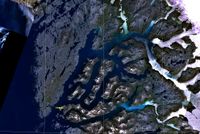 |
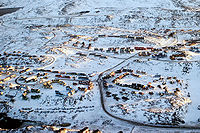 |
|
|
Left:Satellite view. Right:Aerial view of Nuuk
|
||
Nuuk is located at approximately .[7] at the mouth of Nuup Kangerlua, some 10 km (6.2 mi) from the shores of Labrador Sea on the southwestern coast of Greenland, and about 240 km (150 mi) south of the Arctic Circle. Initially, the fjord flows to the northwest, to then turn southwest at , splitting into three arms in its lower run, with three big islands inbetween the arms: Sermitsiaq Island, Qeqertarsuaq Island, and Qoornuup Qeqertarsua.[8]The fjord widens into a bay dotted with skerries near its mouth, opening into Labrador Sea at approximately . The Sermitsiaq mountain looms over the city and can be seen almost everywhere in Nuuk. It is located on an island in the Nuup Kangerlua fjord. The mountain has given its name to the nationwide newspaper Sermitsiaq.
Climate
Nuuk has a maritime influenced subarctic climate with cold, snowy winters and cool summers. Temperatures are below freezing during winter and stay cool in summer.[9] In December, the sun rises at 10.00 and sets at 14:30. By contrast, from late May and early August the days are long. Average temperatures are seven degrees celsius in July and minus eight degrees celsius in January.
| Climate data for Nuuk, Greenland (1961-1990) | |||||||||||||
|---|---|---|---|---|---|---|---|---|---|---|---|---|---|
| Month | Jan | Feb | Mar | Apr | May | Jun | Jul | Aug | Sep | Oct | Nov | Dec | Year |
| Average high °C (°F) | - 4.6 (23.7) |
-4.7 (23.5) |
-5.1 (22.8) |
-1.2 (29.8) |
3.1 (37.6) |
7.0 (44.6) |
9.9 (49.8) |
9.3 (48.7) |
6.0 (42.8) |
1.4 (34.5) |
-1.3 (29.7) |
-3.5 (25.7) |
1.36 (34.45) |
| Average low °C (°F) | - 10.0 (14) |
-10.7 (12.7) |
-10.7 (12.7) |
-6.3 (20.7) |
-1.7 (28.9) |
1.1 (34) |
3.5 (38.3) |
3.5 (38.3) |
1.4 (34.5) |
-2.7 (27.1) |
-5.9 (21.4) |
-8.6 (16.5) |
-3.9 (24.9) |
| Precipitation mm (inches) | 40 (1.57) |
47 (1.85) |
49 (1.93) |
47 (1.85) |
55 (2.17) |
61 (2.4) |
86 (3.39) |
85 (3.35) |
89 (3.5) |
66 (2.6) |
73 (2.87) |
54 (2.13) |
752 (29.61) |
| Source: Danish Meteorological Institute[10] | |||||||||||||
Demographics
With 15,469 inhabitants as of 2010, Nuuk is the fastest-growing town in Greenland,[11] with migrants from the smaller towns and settlements reinforcing the trend. Together with Tasiilaq, it is the only town in the Sermersooq muncipality exhibiting stable growth patterns over the last two decades. The population increased by over a quarter relative to the 1990 levels, and by nearly 16 percent relative to the 2000 levels.[11]

Government and politics
As the capital of Greenland, Nuuk is the administrative centre of the country, containing all of the important government buildings and institutions. The current mayor of Nuuk is Asii Chemnitz Narup from the Inuit Ataqatigiit party.
The national parliament of Greenland, the Landsting, is located in Nuuk. It currently has 31 seats and its members are elected by popular vote on the basis of proportional representation to serve four-year terms. All of Greenland's major politicial parties have their headquarters in Nuuk, including the Inuit Ataqatigiit, Siumut, Democrats, Atassut, Association of Candidates and the Women's Party.
KANUKOKA
KANUKOKA Kalaallisut: Kalaallit Nunaanni Kommunit Kattuffiannit is based in Nuuk. It is an association of Greenland's municipalities, led by Enok Sandgreen.[12] The aim of the organization is to facilitate cooperation between all four municipalities of Greenland: Kujalleq, Qaasuitsup, Qeqqata, and Sermersooq. The organization runs the municipal elections every four years, with the last election taking place in 2008.[13] All municipal authorities in Greenland are currently members of the organization.[14] The association is overseen by Maliina Abelsen, the Minister for Social Affairs in the Government of Greenland.[12][15]
Economy and infrastucture
Although only a small city, Nuuk has developed trade, business, shipping and other industries. Nuuk began as a small fishing settlement with a harbor but as the economy developed rapidly during the 1970s and 1980s, the fishing industry in the capital declined.[16]However, seafood, including fish, seal etc is sold in abundance in Nuuk and the capital contains a number of fish markets, the largest being Kalaaliaraq Market. Minerals such as zinc, gold, etc have contributed to the development of Nuuk's economy.
The city, like much of Greenland, is heavily dependent upon Danish investment and relies on Denmark for block funding.[17]
Energy
All of Greenland's electricity is powered by the government owned company Nukissiorfiit, that has a monopoly on the electricity in Greenland. Nuuk gets its electric power mainly from Buksefjord hydroelectric power plant by way of a 132 kV powerline crossing Ameralik fjord on the world's longest span.
Education

Nuuk has several educational institutions of higher learning. The University of Greenland (Ilisimatusarfik), which is the only university in Greenland, is located in Nuuk. The university expanded in 2007 with the new building called Ilimmarfik which houses departments of journalism, management and economics, language, literature and media, cultural and social history, theology and religion and social work. Nuuk is also home to the Department of Learning (Ilinniarfissuaq), the oldest educational facility in Greenland, located in the old colonial part of Nuuk (Nuutoqaq: Old Nuuk). Other notable educational institutions include the Department of Nursing and Health Science, Nuuk Technical College and the Iron- & Metal School.
Healthcare
The city is served by Queen Ingrid's Hospital. The hospital not only serves as the main hospital for the municipality but is the central hospital in all of Greenland. The hospital has around 130 beds.[18]
Tourism
The Nuuk Tourist Office was built in 1992 to house the headquarters of the new National Tourist Board of Greenland.[19] It was built not only to provide information to tourists but as an attraction, with a fake Christmas tree and an extremely large postal box.
Transport
Air
Nuuk has an international airport located 4 km (2.5 mi) to the northeast of the town centrum. Built in 1979. it a focus city for Air Greenland, which is also headquartered in Nuuk,[20] and operates its technical base at the airport.
Sea
For most of the year, Nuuk is served twice-weekly by coastal ferries of Arctic Umiaq Line which link the communities of the western coast.[21]
Ground
The main street in Nuuk is Aqqusinersuaq, alongside which there is a number of shops and the 140-room Hotel Hans Egede.[22] The majority of 72 buses and 2,570 cars owned in Greenland (as of 2004) operate in Nuuk.[23] Nuup Bussii provides frequent bus services to the outlying districts of Nuussuaq and Qinngorput.
Sites of interest
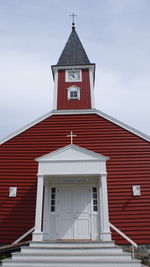
Historical sites
Nuuk Cathedral was established in 1849. The red building with pointy roof is a prominent site on the landscape. The Herrnhut House was the centre of the Moravian Mission station in Nuuk which was active across the west coast. Other landmarks include the Hans Egede Church and the Hans Egede Statue.
Katuaq Culture Centre
Katuaq Culture Centre is a cultural centre used for both concerts cinema, exhibitions and conferences. It was designed by schmidt hammer lassen, it was inaugurated on February 15 1997. Katuaq contains two auditoria, the larger one seating 1,008 people and the smaller one 508. The complex also contains an art school, library, meeting facilities, administrative offices and a café.
University of Greenland
The University of Greenland is located in Nuuk and is the national university of Greenland. Most courses are taught in Danish and a few in Greenlandic. As of 2007, the university had approximately 150 students, almost all local inhabitants, and around 14 academic staff and five technical-administrative employees.[24]Its library holds approximately 18,000 volumes.
Nuuk Kunstmuseum
Nuuk Kunstmuseum is the only private art and crafts museum in Greenland.[25]The museum contains a notable collection of paintings, watercolors, drawings and graphics, figures in soapstone, ivory, and wood, with many items collected by the businessman Svend Junge.[25] Of particular note is a collecitons of over 150 paintings by Emanuel A. Petersen.[25]
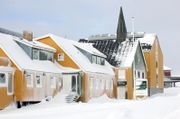
National Museum of Greenland
The National Museum of Greenland is located in Nuuk and was one of the first museums established in Greenland, inaugurated in the mid 1960s.[26] The museum is affiliated with the Danish National Museum which has expanded its collections. The museum has many artifacts related to archaeology, history, art, and handicrafts and also has information about ruins, graveyards, buildings etc.
Kalaallit Nunaata Radioa
Kalaallit Nunaata Radioa (The Greenlandic Broadcasting Corporation or KNR), the national public broadcasting corporation of Greenland is based in Nuuk. It is an independent state-owned corporation headed by a seven-person board. KNR provides one national television station and one national radio station. The radio station operates mostly in the Greenlandic language (Kalaallisut) but also in Danish.
The Greenland Centre for Performing Arts in Nuuk was opened in 1997, as a joint project between the Greenland Government, the Nuuk Municipal Council and the Nordic Council of Ministers. The centre contains a theatre, an exhibition hall and conference facilities and a cafe.[27]
The National Library of Greenland in Nuuk is the largest reference library in the country, devoted to the preservation of national cultural heritage and history.[28]The library holdings are split between the public library in the town centrum, and Ilimmarfik, the campus of the University of Greenland. As of 1 January 2008, there are 83,324 items in the library database at Ilimmarfik.[29]
Sport
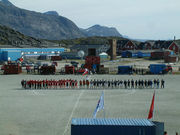 |
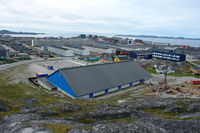 |
|
|
Left:Nuuk Stadium. Right:Godthåbhallen exterior.
|
||
Nuuk Stadium is a multi-purpose stadium, mainly used mostly for football matches. The stadium has a capacity for 2,000[30]. The stadium can also be used as an entertainment venue and recently the Scottish rock band Nazareth, of Love Hurts fame, performed at the venue. Nuuk also has the Godthåbhallen, a handball stadium. It is the home of the Greenland national handball team and has a capacity of 1,000. [31]
Notable people
- Agnethe Davidsen, the first female government minister in Greenland.
- Maliina Abelsen, the Minister for Social Affairs in the Government of Greenland
- Nive Nielsen, singer.
Twin towns
 Cuxhaven, Germany
Cuxhaven, Germany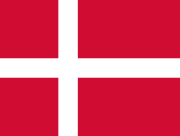 Aalborg (since 2002), Denmark
Aalborg (since 2002), Denmark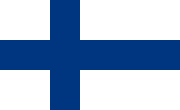 Vantaa (since 1965), Finland
Vantaa (since 1965), Finland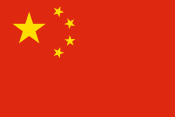 Changchun, China
Changchun, China Tiverton, Rhode Island, United States
Tiverton, Rhode Island, United States Lyngby-Taarbæk, Denmark
Lyngby-Taarbæk, Denmark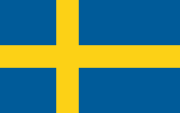 Huddinge, Sweden
Huddinge, Sweden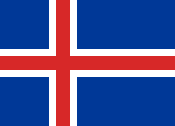 Reykjavík, Iceland
Reykjavík, Iceland Ushuaia, Argentina
Ushuaia, Argentina Bocas del Toro, Panama
Bocas del Toro, Panama

References
- ↑ Statistics Greenland, Greenland in Figures, 2010
- ↑ "Human history". Nuuk Tourism. http://www.nuuk-tourism.gl/database.asp?lang=eng&num=247. Retrieved July 12, 2010.
- ↑ 3.0 3.1 "Nuuk". Encyclopedia Britannica. http://www.britannica.com/EBchecked/topic/422941/Nuuk. Retrieved July 12, 2010.
- ↑ Wurm, Stephen A.; Mühlhäusler, Peter; Tyron, Darrell T. (1996). Atlas of Languages of Intercultural Communication in the Pacific, Asia, and the Americas, International Council for Philosophy and Humanistic Studies. Volume 2, Part 1 Volume 13 of Trends in Linguistics. Walter de Gruyter. p. 1051. ISBN 3110134179. http://books.google.co.uk/books?id=glU0vte5gSkC&pg=PA1051&dq=1733+smallpox+nuuk&hl=en&ei=xkE7TPisJYbQnAePl9SIBA&sa=X&oi=book_result&ct=result&resnum=1&ved=0CCsQ6AEwAA#v=onepage&q=1733%20smallpox%20nuuk&f=false.
- ↑ Nuuk travel guide
- ↑ "CIA World Factbook – Greenland". https://www.cia.gov/library/publications/the-world-factbook/geos/gl.html.
- ↑ Municipality information. De grønlandske kommuners Landsforening, KANUKOKA
- ↑ O'Carroll, Etain (2005). Greenland and the Arctic. Lonely Planet. pp. 154. ISBN 1-74059-095-3.
- ↑ "Extreme temperature records since 1850, meteorologyclimate.com". http://www.meteorologyclimate.com/extreme-temperature-records.htm.
- ↑ Danish Meteorological Institute (Danish)
- ↑ 11.0 11.1 11.2 "Population in localities January 1.st by locality, age, gender and place of birth 1977-2010". Statistics Greenland. http://bank2.stat.gl/dialog/varval.asp?ma=BEEST4&ti=Population+in+localities+January+1%2Est+by+locality%2C+age%2C+gender+and+place+of+birth+1977%2D2010&path=../Database/Greenland/Population/Population%20in%20Greenland/&search=NUUK&lang=4. Retrieved 12 July 2010.
- ↑ 12.0 12.1 "Sermitsiaq mener: Hvem ka’? Kanukoka!" (in Danish). Sermitsiaq. 20 May 2010. http://sermitsiaq.gl/leder/article118782.ece. Retrieved 9 July 2010.
- ↑ "Kommunalvalg 2008" (in Danish). KANUKOKA, Official Website. http://www.kanukoka.gl/da/om_kommunerne/kommunalvalg_2008. Retrieved 9 July 2010.
- ↑ "Hvad er KANUKOKA?" (in Danish). KANUKOKA, Official Website. http://www.kanukoka.gl/da/om_kanukoka/fakta_om_kanukoka/hvad_er_kanukoka. Retrieved 9 July 2010.
- ↑ "Minister for Social Affairs". Government of Greenland. http://uk.nanoq.gl/emner/government/departments/ministry_of_social_affairs/minister.aspx. Retrieved 9 July 2010.
- ↑ Jones, Michael; Olwig, Kenneth (2008). Nordic landscapes: region and belonging on the northern edge of Europe. University of Minnesota Press. p. 118. http://books.google.co.uk/books?id=cXLAeyDeaUMC&pg=PA118&dq=nuuk+economy&hl=en&ei=SkY7TPybGpOWsgOG6c3aCg&sa=X&oi=book_result&ct=result&resnum=1&ved=0CC0Q6AEwAA#v=onepage&q=nuuk%20economy&f=false.
- ↑ World of Information Regional Review: Europe. Kogan Page Publishers. 2003. p. 164. ISBN 0749440678. http://books.google.co.uk/books?id=Hwi0s3I5jLEC&pg=PA164&dq=nuuk+economy&hl=en&ei=UkU7TLWLF4y8sQPE2sjaCg&sa=X&oi=book_result&ct=result&resnum=2&ved=0CDIQ6AEwAQ#v=onepage&q=nuuk%20economy&f=false.
- ↑ Bjerregaard, Peter; Young, T. Kue (1998). The circumpolar Inuit: health of a population in transition. Wiley-Blackwell. p. 55. ISBN 8716119053. http://books.google.co.uk/books?id=6Ko25S59XdwC&pg=PA55&dq=Queen+Ingrid%27s+Hospital&hl=en&ei=vWE7TPD1HYnQsAOkur3aCg&sa=X&oi=book_result&ct=result&resnum=1&ved=0CC0Q6AEwAA#v=onepage&q=Queen%20Ingrid%27s%20Hospital&f=false.
- ↑ Europa World Year, Book 1. Taylor & Francis Group. p. 1458. ISBN 1857432541. http://books.google.co.uk/books?id=x7v0M2mZHpMC&pg=PA1458&dq=Nuuk+Tourist+Office&hl=en&ei=Mm47TKXKJI6gsQP-t4HaCg&sa=X&oi=book_result&ct=result&resnum=2&ved=0CDoQ6AEwAQ#v=onepage&q=Nuuk%20Tourist%20Office&f=false.
- ↑ airgreenland.com
- ↑ "AUL, Timetable 2009" (PDF). Arctic Umiaq Line. http://www.aul.gl/images/stories/pdf/fartplan%2009.pdf. Retrieved 13 July 2010.
- ↑ Hotel Hans Egede
- ↑ O'Carroll, Etain (2005). Greenland and the Arctic. Lonely Planet. pp. 231. ISBN 1-74059-095-3.
- ↑ About the University. "ca. 150 studenter; 14 lærere foruden rektor samt 5 teknisk-administrativt ansatte."
- ↑ 25.0 25.1 25.2 www.kunstmuseum.gl
- ↑ www.natmus.gl
- ↑ "Greenland". Danish Exporters. http://www.danishexporters.dk/scripts/danishexporters/regionsGreenland.asp. Retrieved July 12, 2010.
- ↑ "About Us". Groenlandica, Greenlandic National Library. http://www.groenlandica.gl/eng/om_os/index_om_os.html?Mode_ID=0. Retrieved 9 July 2010.
- ↑ "Collections". Groenlandica, Greenlandic National Library. http://www.groenlandica.gl/eng/materialer/index_materialer.html?Mode_ID=0. Retrieved 9 July 2010.
- ↑ World Stadiums entry
- ↑ World Stadiums: Stadiums in Greenland
|
|||||||||||||||||
|
||||||||||||||||